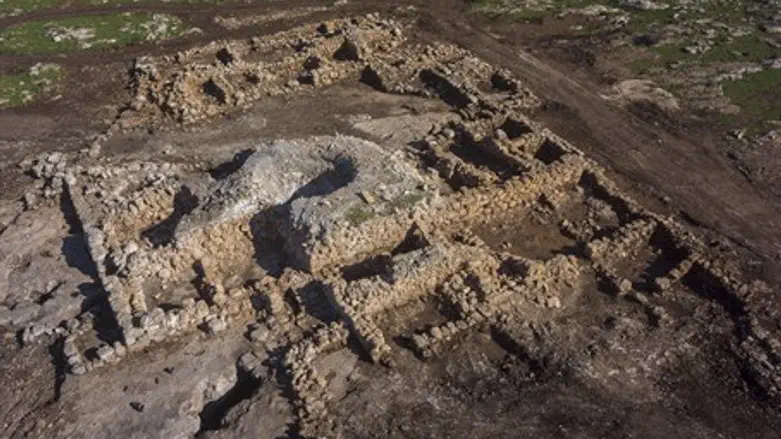
Israel Antiquities Authority (IAA) excavations ahead of the construction of a new neighborhood in the coastal city of Rosh Ha'ayin to the east of Petah Tikva have uncovered an ancient farmhouse, along with an ancient monastery.
Dozens of teenagers from preparatory programs and youth villages are taking part in the excavation, which has unearthed an ancient 2,700-year-old farmhouse from the First Temple period spanning 30 x 50 meters, as well as a 1,500-year-old church with colorful mosaics and inscriptions.
"The large farmhouse was preserved to a height of more than two meters. The building is 2,700 years old and included twenty-four rooms constructed around a central courtyard," explained Amit Shadman, excavation director on behalf of the IAA.
"A large storage compartment (silo) meant to protect the grain was exposed in the courtyard. It seems that carbohydrates were as popular then as now, and the growing and processing of grain were fairly widespread in the rural-agricultural region. This was corroborated by other discoveries in the field that included numerous millstones which were used to grind the grain into flour."
"In addition, we found simple rock-hewn oil presses used in the production of olive oil," said Shadman, who noted that among the artifacts found in the farmhouse were two silver coins from the fourth century BCE that bear the likenesses of the Greek goddess Athena and the Athenian owl.
The excavation director explained that the farm and other similar ones were operational for centuries until the Hellenistic period when the region was abandoned.
Hundreds of years later during the fifth century CE, a wave of Christian settlement arrived in the area, with the presence attested to by the rural churches recently exposed.
The monastery dating to the Byzantine period that was found on one of the hills in the area included a church, an oil press, residential quarters and stables equipped with mangers and troughs.
The church's floors featured colorful mosaics with geometric and other designs. Likewise, a Greek inscription ascribed to a priest named Theodosius - a common name in the Byzantine period - was revealed in one of the mosaics.
"This place was built under Theodosius the priest. Peace be with you when you come, peace be with you when you go, Amen," reads the mosaic.
Hundreds of years after the monastery went out of usage, a lime kiln was established there during the Ottoman period of Turkish rule, during which large parts of the monastery were destroyed.
The IAA decided to conserve the ancient remains in situ, to be displayed in the communal areas of the new neighborhoods that will be open for the benefit of the public.

Aerial view of the farmstead Griffin Aerial Photography

Aerial view of the church Griffin Aerial Photography



Pictures of the mosaics discovered in the monastery Assaf Peretz, courtesy of the Israel Antiquities Authority

Picture of coin bearing the image of the goddess Athena which was discovered in the farmhouse Israel Antiquities Authority.

Picture of coin bearing the image of the Athenian owl which was discovered in the farmhouse Israel Antiquities Authority.